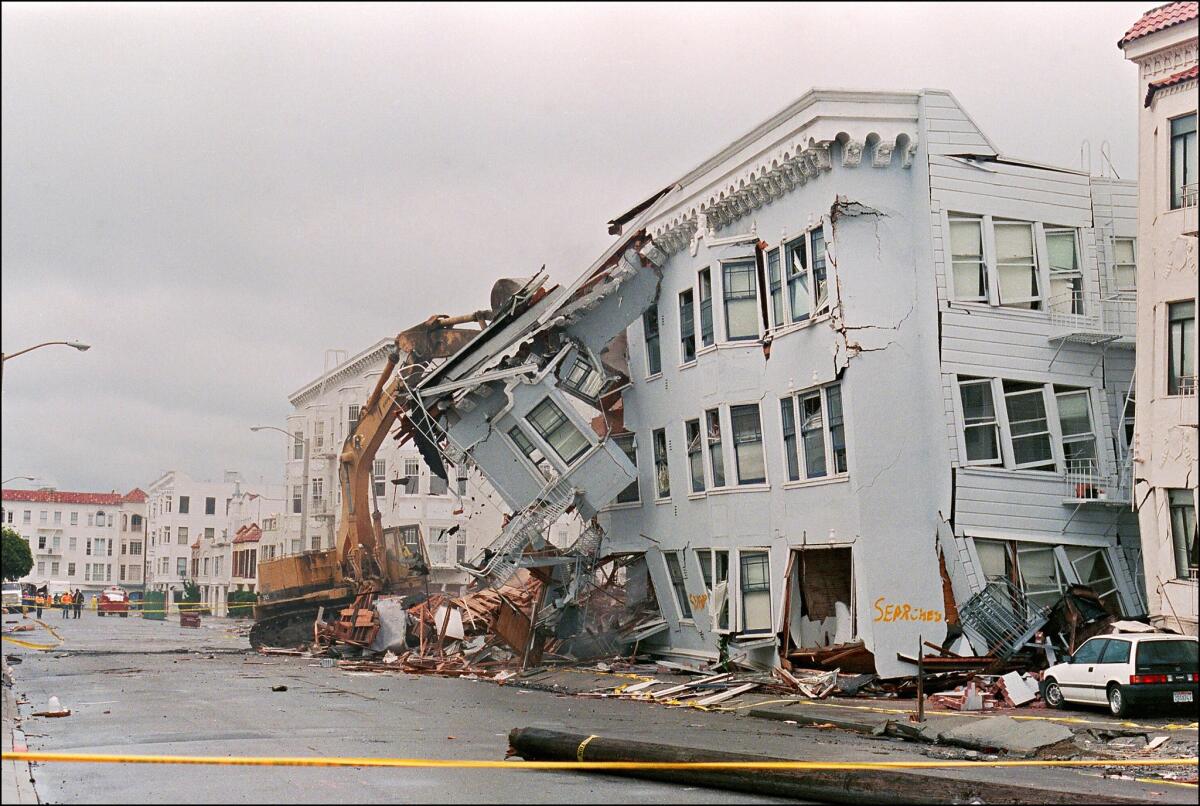L.A. earthquake retrofit bill passes key hurdle at City Hall

The front of an apartment building in the Marina District in San Francisco collapsed in the 1989 Loma Prieta earthquake.
- Share via
A landmark effort to require earthquake retrofits of as many as 15,000 buildings in Los Angeles passed a key hurdle Wednesday, as the City Council’s housing committee approved the legislation on a 4-0 vote.
The City Council is scheduled to consider the full legislation on Friday.
If approved, the law proposed by Mayor Eric Garcetti would be the most sweeping earthquake safety measure in California history. It would require retrofits of as many as 13,500 wooden apartment buildings and 1,500 brittle concrete buildings.
The collapse of such buildings have killed more than 65 people during the last two major earthquakes that struck Los Angeles.
The threat has been known for years. Earthquakes can cause chunks of concrete to burst from building columns and crumple the skinny poles that hold up carports in wooden apartment complexes. For two decades, City Hall has largely ignored calls to require fixes, concerned about costs; retrofits can cost $60,000 to $130,000 for wooden apartment buildings and millions of dollars for taller concrete buildings.
After The Times reported in 2013 that as many as 50 out of more than 1,000 concrete buildings in L.A. could be destroyed in a big quake, the issue of safety gained renewed attention.
Last year, the mayor announced an ambitious effort to get quake-vulnerable buildings fixed. He appointed a U.S. Geological Survey seismologist, Lucy Jones, to serve as his earthquake science advisor. In January, the City Council’s housing committee, led by Councilman Gil Cedillo, began reviewing Garcetti’s proposal.
Their efforts reached a key moment at Wednesday’s hearing. Renter and owner groups opposed the bill’s four-year deadline to finish the wooden apartment retrofits once owners receive an order to make those improvements. The committee agreed to change the deadline to seven years.
The deadline for concrete building retrofits remains the same — 25 years.
After the extension was granted, owner and renter groups dropped their opposition, and said other concerns could be dealt with later. “What we got today was very, very positive, and we’re ready to move forward,” said Jim Clarke of the Apartment Assn. of Greater Los Angeles.
Garcetti has said he would not support a longer retrofit timeline. But on Wednesday, Connie Llanos, a spokeswoman for the mayor, said he “understands that in the deliberative process, sometimes you need to make adjustments to get things passed.”
In a statement, Garcetti hailed the committee’s vote. “These retrofits to some of L.A.’s most vulnerable buildings will have life-saving consequences,” he said.
Still to be decided in the coming weeks or months is how the retrofit costs will be shared between owners and tenants. Generally, rents in apartments built before Oct. 1, 1978, are subject to rent control in Los Angeles, which restricts how much rents can be raised.
Tenants would prefer that landlords pay all the retrofit costs. Apartment groups are hoping for financial support, such as reductions in property and state income taxes, as well as business license and building permit fees, for owners who retrofit.
The city’s housing department has recommended a 50-50 split between owners and renters, with tenants paying as much as $38 a month. The maximum monthly surcharge allowed is $75.
Decreasing the burden on renters is essential, said Larry Gross, executive director of the Coalition for Economic Survival. “Otherwise, we’re going to lose tenants. They’re going to be displaced.”
Cedillo, the chairman of the housing committee, said the retrofit law would send an important message: “That Los Angeles is going to be a safe place to work and live.”
Councilman Felipe Fuentes said the requirement would ensure the quake safety of affordable.
“Doing nothing is no longer an option,” he said. “It’s important for us to do something.”
Follow us on Twitter: @ronlin and @RosannaXia
ALSO:
Garcetti hopes to have L.A.’s quake retrofit laws in place this year
As San Francisco rents soar, tenants still willing to pay for earthquake safety
30 years after Mexico City quake, hundreds still live in temporary camps
More to Read
Sign up for Essential California
The most important California stories and recommendations in your inbox every morning.
You may occasionally receive promotional content from the Los Angeles Times.












